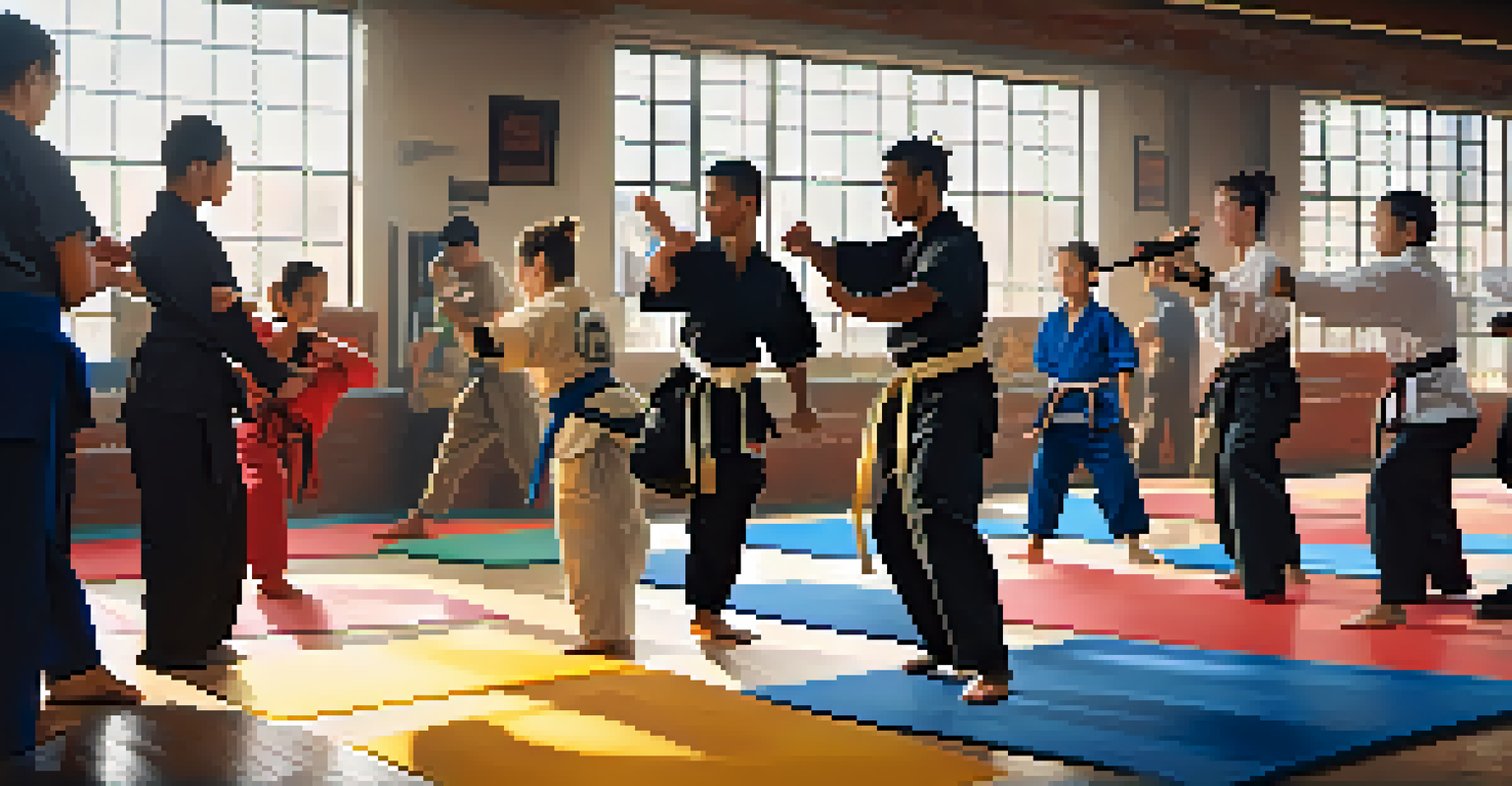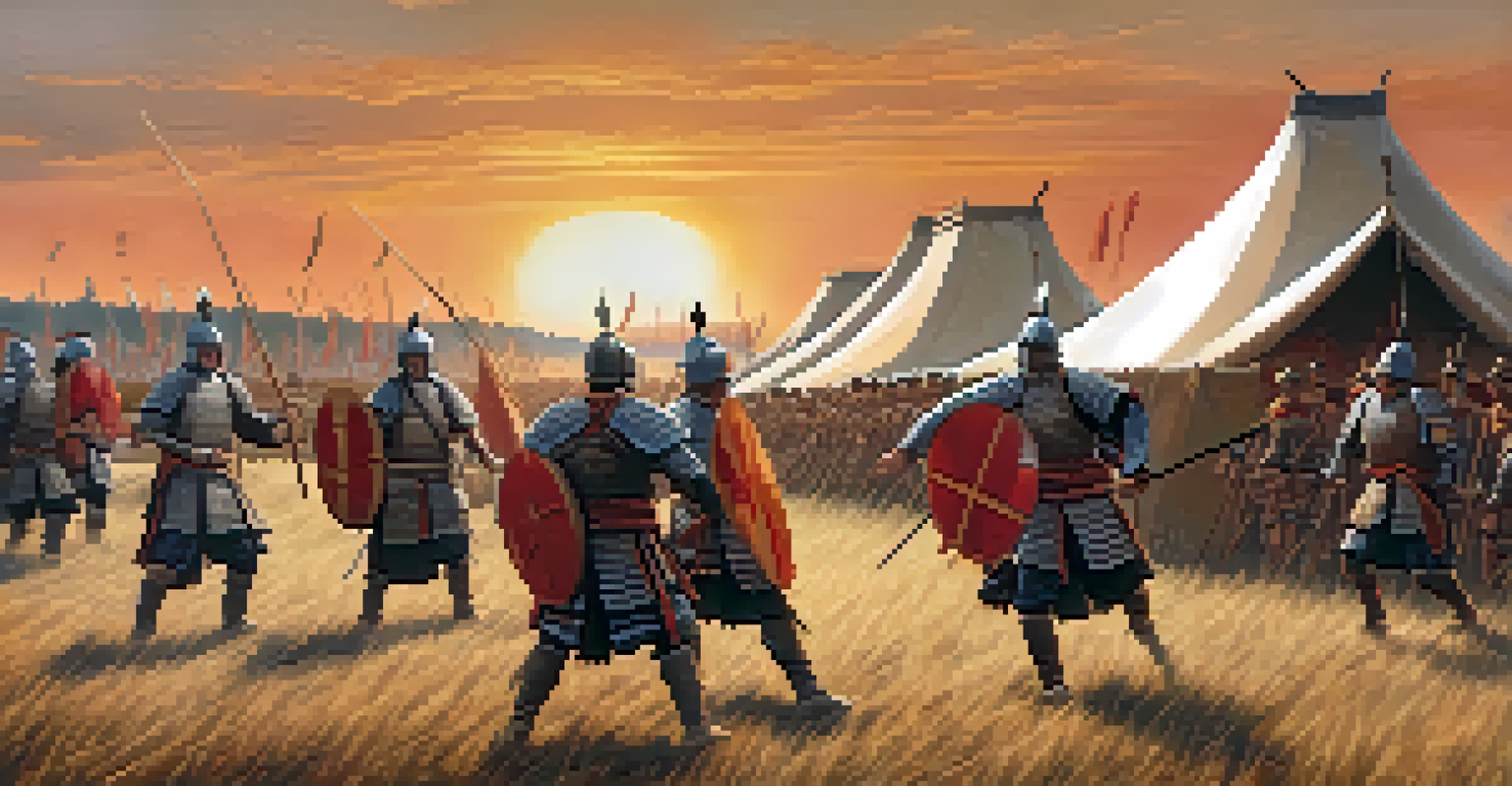The Historical Development of Weapon-Based Martial Arts

Origins of Weapon-Based Martial Arts in Ancient Civilizations
Weapon-based martial arts trace their roots back to ancient civilizations where combat was essential for survival. From the Egyptian charioteers to the Greek hoplites, the skills in wielding weapons were crucial in warfare. These early forms often included techniques that combined physical prowess with strategic thinking, laying the groundwork for future martial arts. As cultures evolved, so did their approaches to weaponry, reflecting their values and societal norms.
Martial arts is not about fighting; it is about building character, teaching discipline, and developing a sense of respect for oneself and others.
For instance, the samurai of Japan developed a unique set of techniques centered on the katana, emphasizing precision and honor. Similarly, the Chinese developed various styles that incorporated a wide range of weapons, showcasing their philosophical beliefs about harmony and balance. These early martial arts not only served practical purposes but also became a means of expressing cultural identity, illustrating the deep connection between society and combat traditions.
As trade and exploration expanded, different martial arts began to influence one another. Techniques were shared and adapted across regions, creating a rich tapestry of weapon-based combat styles. This blending of methods and philosophies set the stage for the diverse range of martial arts we see today, demonstrating that the evolution of these practices is as much about cultural exchange as it is about combat efficiency.
The Role of Religion and Philosophy in Martial Arts Development
Throughout history, many weapon-based martial arts have been deeply intertwined with religious and philosophical teachings. For example, in ancient India, the martial art of Kalaripayattu was influenced by Hindu philosophies, emphasizing the balance between mind and body. Similarly, the martial arts of East Asia often incorporate principles from Buddhism and Confucianism, which stress discipline, respect, and self-improvement.

These philosophical underpinnings not only shaped the techniques practiced but also the mindset of practitioners. The focus on mental and spiritual development alongside physical training helped create a holistic approach to martial arts. This connection between philosophy and practice made martial arts a way for individuals to cultivate not just fighting skills, but also personal virtues such as humility and perseverance.
Cultural Influence on Martial Arts
Weapon-based martial arts have evolved through cultural exchanges, blending techniques and philosophies from various civilizations.
As martial arts spread globally, these philosophical elements were often maintained, providing a unifying thread among diverse styles. This melding of combat skills with spiritual growth continues to resonate with practitioners, highlighting that weapon-based martial arts are about more than just physical prowess; they are a pathway to personal transformation and understanding.
The Influence of Warfare on Martial Arts Techniques
Warfare has always been a significant driver of martial arts development, with techniques evolving in response to the changing landscape of battle. As weapons technology advanced, so too did the skills required to wield them effectively. For instance, the introduction of firearms in the 16th century led to the refinement of close-combat techniques, as warriors needed to protect themselves in the heat of battle while adapting to new forms of combat.
The ultimate aim of martial arts is not having to use them.
In many cultures, the martial arts practiced by soldiers often became formalized into structured systems of training. The European knights developed techniques such as the German school of swordsmanship, which emphasized grappling and disarmament, while the Japanese developed various forms of kenjutsu and iaijutsu. This evolution reflected not only the practical needs of warfare but also the honor and tradition associated with being a warrior.
As conflicts arose and nations clashed, martial arts became a means of preserving combat knowledge and training elite fighters. This not only ensured the survival of effective techniques but also created a legacy that would influence civilian martial arts practices. The interplay between warfare and martial arts continues to be a fascinating aspect of their historical journey, with each shaping the other in profound ways.
Martial Arts as a Means of Self-Defense and Empowerment
Beyond warfare, weapon-based martial arts have also served as vital tools for self-defense and personal empowerment throughout history. In many communities, individuals learned weapon techniques not just for combat but to protect themselves and their loved ones. This aspect of martial arts has often intersected with societal issues, such as gender equality and personal safety, making martial arts a relevant practice in modern times.
For example, the rise of women's self-defense classes has highlighted the importance of martial arts in promoting empowerment and confidence. Techniques from various weapon-based systems have been adapted to provide practical skills that can help individuals defend themselves in real-life situations. This shift has made martial arts more accessible and inclusive, encouraging participation from diverse groups seeking safety and confidence.
Philosophy Shapes Training Mindset
Many martial arts incorporate philosophical teachings that emphasize personal growth alongside physical training.
Moreover, the community aspect of martial arts training fosters a supportive environment where individuals can build skills and resilience together. This sense of camaraderie and shared purpose enhances the personal growth that comes from training, making weapon-based martial arts a powerful tool for transformation both on and off the mat.
Cultural Exchanges and Their Impact on Martial Arts
Cultural exchanges have played a significant role in shaping weapon-based martial arts, as different styles and philosophies have been shared across borders. The Silk Road, for instance, facilitated not just trade but also the exchange of martial knowledge, leading to the blending of techniques from various cultures. This cross-pollination enriched martial arts, creating hybrid styles that incorporated the strengths of different traditions.
In modern times, globalization has further accelerated this exchange, with martial artists traveling and sharing their knowledge worldwide. The popularity of martial arts films and competitions has also contributed to this phenomenon, showcasing the diversity and richness of various styles. This exposure has allowed practitioners to learn from one another, fostering a greater appreciation of different cultural approaches to combat.
As a result, we now see a wide array of weapon-based martial arts being practiced in various forms across the globe. This evolution reflects not just the adaptability of martial arts but also the communal spirit that emerges when cultures come together. Such interactions highlight the universal human desire for self-improvement and mastery, transcending geographical and cultural boundaries.
The Modernization of Weapon-Based Martial Arts in Contemporary Society
In today’s fast-paced world, weapon-based martial arts have undergone significant modernization, adapting to contemporary needs and lifestyles. Many practitioners now focus on fitness, self-defense, and personal development rather than traditional combat scenarios. This shift has led to the emergence of various hybrid forms that combine traditional techniques with modern training methods, making martial arts more accessible to a broader audience.
Moreover, the integration of technology has also influenced how martial arts are taught and practiced. Online classes, instructional videos, and virtual competitions have opened up new avenues for learning, allowing enthusiasts to train from anywhere in the world. This democratization of martial arts training has fostered a vibrant online community where individuals can share their experiences and techniques, further enriching the practice.
Modern Adaptations of Martial Arts
Today's weapon-based martial arts focus on fitness and self-defense, adapting to contemporary lifestyles and technological advancements.
As weapon-based martial arts continue to evolve, they remain relevant in contemporary society by emphasizing self-discipline, respect, and physical fitness. This adaptability ensures that martial arts can thrive in modern contexts, appealing to new generations while preserving the essence of their rich historical traditions.
The Future of Weapon-Based Martial Arts: Trends and Innovations
Looking ahead, the future of weapon-based martial arts is likely to be shaped by emerging trends and innovations that reflect changing societal values. As the emphasis on mental health and well-being increases, we may see a greater focus on the therapeutic benefits of martial arts. Practices that incorporate mindfulness and emotional resilience alongside physical training could become more prevalent, appealing to those seeking holistic personal development.
Additionally, as technology continues to advance, we may expect to see innovative training tools and techniques emerge. Virtual reality (VR) and augmented reality (AR) could offer immersive training experiences, allowing practitioners to refine their skills in dynamic environments. Such innovations could revolutionize how individuals train, making weapon-based martial arts more engaging and effective.

Ultimately, the evolution of weapon-based martial arts will continue to reflect the cultures and communities that practice them. As we embrace new ideas and technologies, we will likely see a fusion of tradition and innovation that preserves the essence of martial arts while making them relevant for future generations. This balance between honoring history and embracing the future will be key to the ongoing journey of weapon-based martial arts.